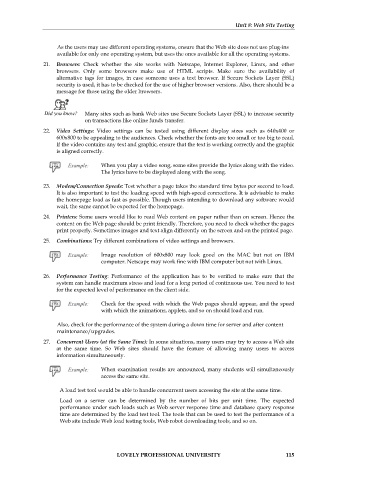Page 122 - SOFTWARE TESTING & QUALITY ASSURANCE
P. 122
Unit 8: Web Site Testing
As the users may use different operating systems, ensure that the Web site does not use plug-ins
available for only one operating system, but uses the ones available for all the operating systems.
21. Browsers: Check whether the site works with Netscape, Internet Explorer, Linux, and other
browsers. Only some browsers make use of HTML scripts. Make sure the availability of
alternative tags for images, in case someone uses a text browser. If Secure Sockets Layer (SSL)
security is used, it has to be checked for the use of higher browser versions. Also, there should be a
message for those using the older browsers.
Did you know? Many sites such as bank Web sites use Secure Sockets Layer (SSL) to increase security
on transactions like online funds transfer.
22. Video Settings: Video settings can be tested using different display sizes such as 640x400 or
600x800 to be appealing to the audiences. Check whether the fonts are too small or too big to read.
If the video contains any text and graphic, ensure that the text is working correctly and the graphic
is aligned correctly.
When you play a video song, some sites provide the lyrics along with the video.
The lyrics have to be displayed along with the song.
23. Modem/Connection Speeds: Test whether a page takes the standard time bytes per second to load.
It is also important to test the loading speed with high-speed connections. It is advisable to make
the homepage load as fast as possible. Though users intending to download any software would
wait, the same cannot be expected for the homepage.
24. Printers: Some users would like to read Web content on paper rather than on screen. Hence the
content on the Web page should be print friendly. Therefore, you need to check whether the pages
print properly. Sometimes images and text align differently on the screen and on the printed page.
25. Combinations: Try different combinations of video settings and browsers.
Image resolution of 600x800 may look good on the MAC but not on IBM
computer. Netscape may work fine with IBM computer but not with Linux.
26. Performance Testing: Performance of the application has to be verified to make sure that the
system can handle maximum stress and load for a long period of continuous use. You need to test
for the expected level of performance on the client side.
Check for the speed with which the Web pages should appear, and the speed
with which the animations, applets, and so on should load and run.
Also, check for the performance of the system during a down time for server and after content
maintenance/upgrades.
27. Concurrent Users (at the Same Time): In some situations, many users may try to access a Web site
at the same time. So Web sites should have the feature of allowing many users to access
information simultaneously.
When examination results are announced, many students will simultaneously
access the same site.
A load test tool would be able to handle concurrent users accessing the site at the same time.
Load on a server can be determined by the number of hits per unit time. The expected
performance under such loads such as Web server response time and database query response
time are determined by the load test tool. The tools that can be used to test the performance of a
Web site include Web load testing tools, Web robot downloading tools, and so on.
LOVELY PROFESSIONAL UNIVERSITY 115

